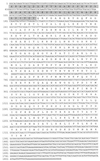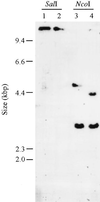Identification of the gene encoding the tryptophan synthase beta-subunit from Chlamydomonas reinhardtii
- PMID: 9625698
- PMCID: PMC34965
- DOI: 10.1104/pp.117.2.455
Identification of the gene encoding the tryptophan synthase beta-subunit from Chlamydomonas reinhardtii
Abstract
We report the isolation of a Chlamydomonas reinhardtii cDNA that encodes the beta-subunit of tryptophan synthase (TSB). This cDNA was cloned by functional complementation of a trp-operon-deleted strain of Escherichia coli. Hybridization analysis indicated that the gene exists in a single copy. The predicted amino acid sequence showed the greatest identity to TSB polypeptides from other photosynthetic organisms. With the goal of identifying mutations in the gene encoding this enzyme, we isolated 11 recessive and 1 dominant single-gene mutation that conferred resistance to 5-fluoroindole. These mutations fell into three complementation groups, MAA2, MAA7, and TAR1. In vitro assays showed that mutations at each of these loci affected TSB activity. Restriction fragment-length polymorphism analysis suggested that MAA7 encodes TSB. MAA2 and TAR1 may act to regulate the activity of MAA7 or its protein product.
Figures






Similar articles
-
A genome's-eye view of the light-harvesting polypeptides of Chlamydomonas reinhardtii.Curr Genet. 2004 Feb;45(2):61-75. doi: 10.1007/s00294-003-0460-x. Epub 2003 Dec 2. Curr Genet. 2004. PMID: 14652691 Review.
-
5-Fluoroindole resistance identifies tryptophan synthase beta subunit mutants in Arabidopsis thaliana.Genetics. 1995 May;140(1):303-13. doi: 10.1093/genetics/140.1.303. Genetics. 1995. PMID: 7635295 Free PMC article.
-
The Chlamydomonas reinhardtii gtr gene encoding the tetrapyrrole biosynthetic enzyme glutamyl-trna reductase: structure of the gene and properties of the expressed enzyme.Plant Mol Biol. 2005 Jul;58(5):643-58. doi: 10.1007/s11103-005-6803-x. Plant Mol Biol. 2005. PMID: 16158240
-
Isolation and characterization of a mutant protoporphyrinogen oxidase gene from Chlamydomonas reinhardtii conferring resistance to porphyric herbicides.Plant Mol Biol. 1998 Nov;38(5):839-59. doi: 10.1023/a:1006085026294. Plant Mol Biol. 1998. PMID: 9862501
-
Structure and light-regulated expression of the gsa gene encoding the chlorophyll biosynthetic enzyme, glutamate 1-semialdehyde aminotransferase, in Chlamydomonas reinhardtii.Plant Mol Biol. 1994 Feb;24(4):617-29. doi: 10.1007/BF00023558. Plant Mol Biol. 1994. PMID: 8155881
Cited by
-
Molecular map of the Chlamydomonas reinhardtii nuclear genome.Eukaryot Cell. 2003 Apr;2(2):362-79. doi: 10.1128/EC.2.2.362-379.2003. Eukaryot Cell. 2003. PMID: 12684385 Free PMC article.
-
A novel rhodanese is required to maintain chloroplast translation in Chlamydomonas.Plant Mol Biol. 2012 Jul;79(4-5):495-508. doi: 10.1007/s11103-012-9926-x. Epub 2012 May 29. Plant Mol Biol. 2012. PMID: 22644440
-
A genome's-eye view of the light-harvesting polypeptides of Chlamydomonas reinhardtii.Curr Genet. 2004 Feb;45(2):61-75. doi: 10.1007/s00294-003-0460-x. Epub 2003 Dec 2. Curr Genet. 2004. PMID: 14652691 Review.
-
A ferroxidase encoded by FOX1 contributes to iron assimilation under conditions of poor iron nutrition in Chlamydomonas.Eukaryot Cell. 2008 Mar;7(3):541-5. doi: 10.1128/EC.00463-07. Epub 2008 Feb 1. Eukaryot Cell. 2008. PMID: 18245275 Free PMC article.
-
A cyclical marker system enables indefinite series of oligonucleotide-directed gene editing in Chlamydomonas reinhardtii.Plant Physiol. 2024 Dec 2;196(4):2330-2345. doi: 10.1093/plphys/kiae427. Plant Physiol. 2024. PMID: 39179421 Free PMC article.
References
-
- Altschul SF, Gish W, Miller W, Myers EW, Lipman DJ. Basic local alignment search tool. J Mol Biol. 1990;215:403–410. - PubMed
-
- Auerbach S, Gao J, Gussin GN. Nucleotide sequences of the trpI, trpB, and trpA genes of Pseudomonas syringae: positive control unique to fluorescent pseudomonads. Gene. 1993;123:25–32. - PubMed
Publication types
MeSH terms
Substances
Associated data
- Actions
Grants and funding
LinkOut - more resources
Full Text Sources
Other Literature Sources

